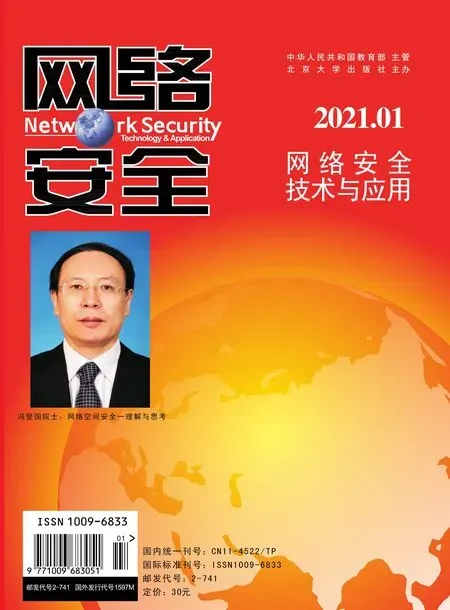内积加密技术原理及其应用
◆王国环
内积加密技术原理及其应用
◆王国环
(联通集团财务有限公司 北京 100032)
大数据时代,信息的远程存储给数据的隐私保护和数据的有效共享带来了严峻的挑战,内积加密这一新型密码体制,融合了传统加密与秘密共享思想,能够在保证数据机密性的同时,实现有效的数据计算、检索与访问控制。由于内积加密具有重要的理论研究意义和广泛的实际应用价值,这类密码体制一经提出,就引起了研究者的广泛关注。本文首先回顾了内积加密的起源与研究进展,然后系统介绍了算法相关原理与定义,并详细描述了内积加密的几个实际应用场景:生物认证、最近邻搜索、加密细粒度访问控制,最后总结了有待进一步研究的问题与方向。
内积加密;隐私保护;数据共享
1976年,Diffie和Hellman[1]提出了公钥密码学(Public-Key Cryptography,PKC)的概念,开创了密码学的新纪元。与对称密码体制中发送方和接收方共享同一个密钥不同,公钥密码体制中,用户密钥由私钥和相应的公钥组成。公钥可以全网公开,而私钥则由用户秘密保存。并且,公私钥计算具有单向性,由公钥推导出私钥在计算上是不可行的。在公钥加密算法中,发送方使用接收方的公钥加密消息,接收方使用自己的私钥解密获得明文消息;而在数字签名算法中,发送方使用自己的私钥签名消息并将其发送给验证者,验证者可使用发送方的公钥验证签名有效性。
PKC解决了对称密码面临的可靠密钥传输和数字签名难题。然而,为了防止假冒,公钥需要由可信的第三方认证并颁发公钥证书。在大型系统中,公钥将消耗大量存储空间。为了简化公钥管理,Shamir[2]提出了使用用户身份(例如姓名、电子邮件地址等)作为公钥的思想,相应的密钥由密钥生成中心(Key Generation Centre, KGC)生成。通过IBE,发送方使用KGC的公钥和接收方的身份来加密消息,接收方则利用KGC分发的私钥来解密消息。但他仅介绍了基于身份的数字方案,并没有给出基于身份加密的构造方法。直到2001年,Boneh和Franklin[3]首次提出了完善的IBE方案,并基于随机预约模型证明了该方案在椭圆曲线CDH(Computational Diffie-Hellman,CDH)假设和适应性选择密文攻击(adaptive chosen ciphertext attack,CCA)下的安全性。
随着IBE的不断演进与发展,Sahai和Waters[4]提出了模糊基于身份加密,也被看作是基于属性加密(Attribute-Based Encryption , ABE)最初的形式。在ABE中,由属性和策略来标识身份,加解密过程不再局限于“一对一”,而是可以实现“一对多”的解密。如果策略与密文相关而属性与用户密钥相关,这类ABE称为密文策略的基于属性加密(Ciphertext-Policy Attribute-Based Encryption,CP-ABE)[5]。例如,发送方使用策略“计算机学院 or 研究生”来加密CP-ABE的密文,任意拥有属性“计算机学院”或者属性“研究生”的用户,就可以解密该密文。另一种类型的ABE被称为密钥策略的基于属性加密(Key-Policy Attribute-Based Encryption,KP-ABE)[6]。KP-ABE中,属性和策略分别与密文和用户密钥相关。ABE的策略最初是以阈值的方式[4]实现的,故而能表达的策略类型有限。为了丰富策略类型,Goyal等人[7]提出了一种支持细粒度访问控制的KP-ABE方案,使用了单调跨度程序来构成访问结构从而能够支持访问数中的“与”门和“或”门。


1 内积加密基本原理与定义

1.1 IPE1算法与安全性定义

阶段1查询:
2 内积加密的应用


3 结语

[1]W. Diffie and M.E. Hellman. New directions in cryptography, IEEE Transactions on Information Theory,22(6):644-654,1976.
[2]A.Shamir.Identity-based cryptosystems and signature schemes.In Proceedings in Cryptology - CRYPTO,196:47-53,1985.
[3]D.Boneh and M. Franklin. Identity-based encryption from the weil pairing. In Proceedings in Cryptology - CRYPTO,2139:213-229,2001.
[4]A.Sahai and B. Waters. Fuzzy identity-based encryption. In Proceedings in EUROCRYPT,3494:457-473,2005.
[5]J.Bethencourt,A. Sahai,and B. Waters. Ciphertext-policy attribute based encryption. In IEEE Symposium on Security and Privacy,2007. SP '07,pp. 321-334,2007.
[6]A.Sahai and B. Waters. Fuzzy identity-based encryption. In Proceedings in Cryptology - EUROCRYPT,3494:457-473,2005.
[7]V.Goyal,O.Pandey,Amit Sahai et al.Attribute-basedencryption for fine-grained access control of encrypted data.InProceedings of the 13th ACM Conference on Computer and Communications Security,CCS '06,pp.89-98,2006.
[8]A.Lewko,T.Okamoto,A. Sahai et al. Fully secure functional encryption:Attribute-based encryption and(hierarchical)inner product encryption.In Proceedings in EUROCRYPT 2010,pp.62-91,2010.
[9]D.Boneh,A.Sahai,and B.Waters. Functional encryption:Definitions and challenges.In Theory of Cryptography,pp.253-273,2011.
[10]X.Boyen,B.Waters.Anonymous hierarchical identity-based encryption(without random oracles).In Proceedings in Cryptology - CRYPTO,pp. 290-307,2006.
[11]S. Kim,K. Lewi,A.Mandal et al.Function-hiding inner product encryption is practical.In:IACR Cryptology ePrint Archive,Vol. 2016,440.2016.
[12]A.Bishop,A. Jain,L. Kowalczyk, Function-hiding inner product encryption. Iin Proceedings in ASIACRYPT, 2015.
[13]J.Katz,A.Sahai,B.Waters, Predicate encryption supporting disjunctions,polynomial equations,and inner products. In Proceeding in EUROCRYPT,pp.146-162,2008.
[14]N.Attrapadung,B. Libert, Functional encryption for inner product: Achieving constant-size ciphertexts with adaptive security or support for negation. In Proceedings in PKC,pp.384-402 2010.
[15]B.Waters,A punctured programming approach to adaptively secure functional encryption. In Proceedings in CRYPTO,2015.
[16]S.Garg,C.Gentry,S.Halevi,M.Zhandry,Functional encryption without obfuscation. In Proceedings in TCC,2016.
[17]E.Shen,E. Shi,B. Waters,Predicate privacy in encryption systems. In Proceedings in TCC,2009.
[18]D.Boneh,A.Raghunathan,G.Segev,Function-privateidentity-based encryption:Hiding the function in functionalencryption. In Proceedings in. CRYPTO,2013.
[19]S. Kim,K. Lewi,A. Mandal et al. Function-hiding inner product encryption is practical. In:IACR Cryptology ePrint Archive,Vol. 2016,pp. 440,2016.
[20]S. Kim,J. Kim,J. H. Seo,A new approach to practical function-private inner product encryption. Theoretical Computer Science,783(2019):22-40,2019.
[21]T. Okamoto,K. Takashima,Fully secure unboundedinner-product and attribute-based encryption. In Proceedings in ASIACRYPT,pp. 349-366,2012.
[22]T. Okamoto,K. Takashima,Achieving short ciphertexts or short secret-keys for adaptively secure general inner-product encryption,Designs Codes and Cryptography 77(2):725-771,2015.
[23]S.Agrawal,D.M. Freeman,V.Vaikuntanathan,Functional encryption for inner product predicates from learning with errors. In Proceedings in ASIACRYPT,pp. 21-40,2011.
[24]N. Attrapadung, B. Libert, Functional encryption for inner product: Achieving constant-size ciphertexts with adaptive security or support for negation. In Proceeding in Public Key Cryptography – PKC,pp. 384-402,2010.

